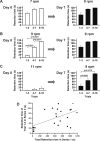Assessment of retention and attenuation of motor-learning memory by repeated rotor-rod analyses
- PMID: 39730861
- PMCID: PMC11680816
- DOI: 10.1038/s41598-024-82108-0
Assessment of retention and attenuation of motor-learning memory by repeated rotor-rod analyses
Abstract
Retention of acquired learning memory is essential for reasonable behavior and crisis avoidance of individuals. Therefore, establishment of a system suitable for analysis of the retention/attenuation of acquired memory is desired. In the present study, mice were conducted on the repeated rotor-rod test, consisting of two series of experiments (Series 1 and 2) of 10 trials each. When rotating speed was 9 rpm, retention time on the rod was gradually increased and reached the maximum value within 10 trials in Series 1. When Series 2 was performed 1 or 3 days after Series 1, retention time of trials 1-3 in Series 2 was not significantly different from that of trials 8-10 in Series 1. On the other hand, retention time of trials 1-3 in Series 2 was significantly declined from that of trials 8-10 in Series 1 when Series 2 was conducted day 7, and returned to the initial level, the same level with trials 1-3 in Series 1, when Series 2 was conducted on days 14 or 30. These results indicate that acquired motor-learning memory is retained for 3 days at least, began to decline by day 7 and returned to the initial level by day 14. In older mice of 10-11 months old, there was a delay in the acquisition of motor learning in Day 0, whereas the retention was not impaired in Day 7. The repeated rotor-rod analyses may useful for research on factors affecting retention/attenuation and acquisition of motor-learning memory and proceed our understanding of motor-learning memory.
© 2024. The Author(s).
Conflict of interest statement
Declarations. Competing interests: The authors declare no competing financial and non-financial interests.
Figures







Similar articles
-
Contributions of the cerebellum and the motor cortex to acquisition and retention of motor memories.Neuroimage. 2014 Sep;98:147-58. doi: 10.1016/j.neuroimage.2014.04.076. Epub 2014 May 9. Neuroimage. 2014. PMID: 24816533 Free PMC article.
-
Age-related impairments of new memories reflect failures of learning, not retention.Learn Mem. 2009 Sep 30;16(10):590-4. doi: 10.1101/lm.1503209. Print 2009 Oct. Learn Mem. 2009. PMID: 19794183 Free PMC article.
-
Impaired long-term memory retention and working memory in sdy mutant mice with a deletion in Dtnbp1, a susceptibility gene for schizophrenia.Mol Brain. 2008 Oct 22;1:11. doi: 10.1186/1756-6606-1-11. Mol Brain. 2008. PMID: 18945333 Free PMC article.
-
Role of the somatosensory cortex in motor memory consolidation.J Neurophysiol. 2020 Sep 1;124(3):648-651. doi: 10.1152/jn.00770.2019. Epub 2020 Jul 29. J Neurophysiol. 2020. PMID: 32727313 Review.
-
Learning and memory in the SAMP8 mouse.Neurosci Biobehav Rev. 1998;22(1):1-20. doi: 10.1016/s0149-7634(96)00063-2. Neurosci Biobehav Rev. 1998. PMID: 9491937 Review.
Cited by
-
The Effectiveness of an Exercise Program Based on Motor Learning Principles for the Correction of the Forward Head Posture: A Randomized Controlled Trial.Brain Sci. 2025 Aug 15;15(8):873. doi: 10.3390/brainsci15080873. Brain Sci. 2025. PMID: 40867204 Free PMC article.
References
-
- Brayne, C. The elephant in the room—healthy brains in later life, epidemiology and public health. Nat. Rev. Neurosci.8, 233–239. 10.1038/nrn2091 (2007). - PubMed
-
- Deary, I. J. et al. Age-associated cognitive decline. Br. Med. Bull.92, 135–152. 10.1093/bmb/ldp033 (2009). - PubMed
-
- Pennisi, G., Bella, R. & Lanza, G. Motor cortex plasticity in subcortical ischemic vascular dementia: What can TMS say?. Clin. Neurophysiol.126, 851–852. 10.1016/j.clinph.2014.09.001 (2015). - PubMed
-
- Boyden, E. S., Katoh, A. & Raymond, J. L. Cerebellum-dependent learning: The role of multiple plasticity mechanisms. Annu. Rev. Neurosci.27, 581–609. 10.1146/annurev.neuro.27.070203.144238 (2004). - PubMed
MeSH terms
LinkOut - more resources
Full Text Sources
Medical

